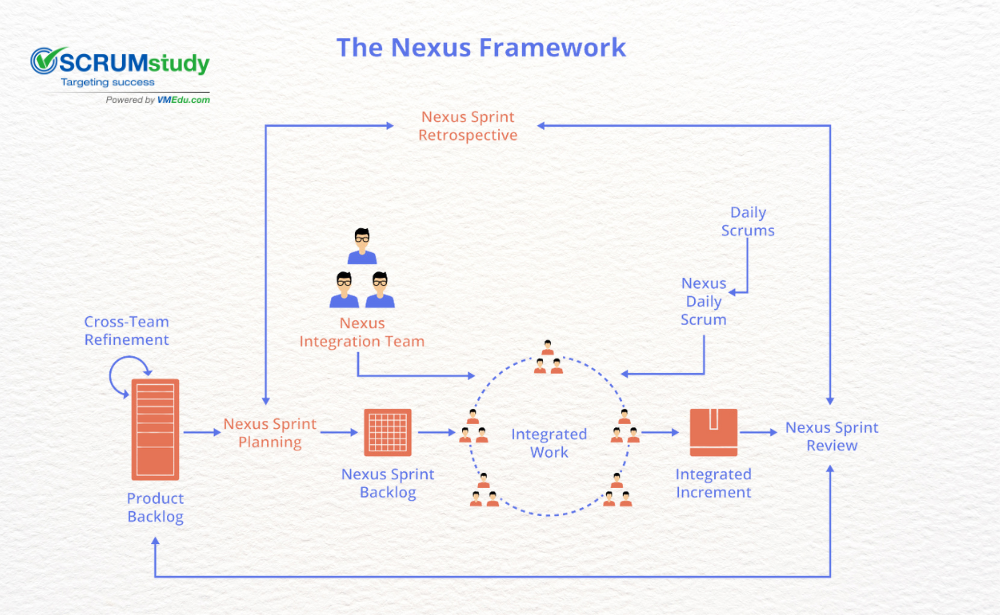
Scaling Scrum for large projects can be challenging but incredibly rewarding. The key lies in maintaining the principles of Agile while adapting the framework to handle greater complexity, more stakeholders, and larger teams. In this blog, we’ll explore effective strategies and frameworks that can help you scale Scrum successfully for larger projects.
Why Scale Scrum?
As projects grow in size and complexity, the need for effective coordination and communication becomes paramount. Scaling Scrum ensures that multiple teams can work together efficiently, maintain Agile principles, and deliver value incrementally. The goal is to manage the increased scope without sacrificing the flexibility, transparency, and collaboration that Scrum promotes.
Key Strategies for Scaling Scrum
Implement Scrum of Scrums (SoS)
- What is SoS?: Scrum of Scrums is a technique used to coordinate work across multiple Scrum teams. Representatives from each team meet regularly to discuss progress, dependencies, and impediments.
- How it works: These meetings follow a similar format to the Daily Standup but focus on issues that impact multiple teams. It helps in synchronizing efforts and addressing cross-team challenges.
Use Scaled Agile Framework (SAFe)
- What is SAFe?: SAFe is a popular framework designed to scale Agile practices across large enterprises. It provides structured guidance on roles, responsibilities, and processes.
- Key components: SAFe includes multiple levels (Team, Program, Large Solution, and Portfolio) to manage complex projects. It integrates Lean thinking and product development flow to ensure alignment and delivery.
Adopt Large Scale Scrum (LeSS)
- What is LeSS?: LeSS is a framework that extends Scrum principles to larger teams and projects. It emphasizes simplicity and maximizing value.
- Key principles: LeSS maintains a single Product Backlog and one Product Owner, even for large projects. It encourages a minimalistic approach to scaling, focusing on deep Scrum implementation.
Nexus Framework
- What is Nexus?: Nexus is an extension of Scrum designed for scaling. It introduces additional roles, events, and artifacts to manage dependencies and integration issues.
- Key features: Nexus includes the Nexus Integration Team, responsible for ensuring that integrated increments are produced each Sprint. It also introduces Nexus Sprint Planning and Nexus Daily Scrum for enhanced coordination.
Disciplined Agile Delivery (DAD)
- What is DAD?: DAD is a hybrid framework that combines Agile, Lean, and traditional approaches. It provides a comprehensive toolkit for scaling Agile practices.
- Key aspects: DAD emphasizes a goal-driven approach, allowing teams to choose their way of working based on the context. It provides guidance on technical practices, governance, and enterprise awareness.
Best Practices for Scaling Scrum
- Maintain Agile Principles: Ensure that the core principles of Agile, such as iterative development, continuous feedback, and collaboration, remain intact even as you scale.
- Effective Communication: Foster open and transparent communication across all teams. Regular meetings, collaboration tools, and clear documentation help in keeping everyone aligned.
- Unified Vision and Goals: Establish a clear product vision and goals that all teams can work towards. A unified direction helps in synchronizing efforts and achieving common objectives.
- Empower Teams: Encourage self-organization and autonomy among teams. Empowered teams are more likely to take ownership and deliver high-quality results.
- Continuous Improvement: Promote a culture of continuous improvement. Regular retrospectives and feedback loops help in identifying areas for enhancement and implementing changes.
Challenges and How to Overcome Them
Coordination and Dependencies
- Challenge: Managing dependencies between teams can be complex.
- Solution: Use frameworks like SoS and Nexus to improve coordination and handle dependencies effectively.
Maintaining Quality
- Challenge: Ensuring consistent quality across multiple teams.
- Solution: Implement continuous integration and automated testing practices to maintain high quality.
Change Resistance
- Challenge: Resistance to change among team members and stakeholders.
- Solution: Provide training and support to ease the transition and emphasize the benefits of scaled Agile practices.
Tooling and Infrastructure
- Challenge: Inadequate tooling can hinder scaling efforts.
- Solution: Invest in robust Agile project management tools that support large-scale collaboration and tracking.
Conclusion
Scaling Scrum for large projects requires careful planning, effective frameworks, and a commitment to Agile principles. By implementing strategies such as Scrum of Scrums, SAFe, LeSS, Nexus, and DAD, organizations can manage complexity and deliver value efficiently. Emphasizing communication, continuous improvement, and team empowerment will further enhance the effectiveness of scaling efforts. Embrace these practices to ensure that your large projects are managed with the same agility and responsiveness as smaller ones, driving successful outcomes and organizational growth.
Ready to scale Scrum in your organization? Start by assessing your current practices, selecting the right framework, and fostering a culture of collaboration and continuous improvement.